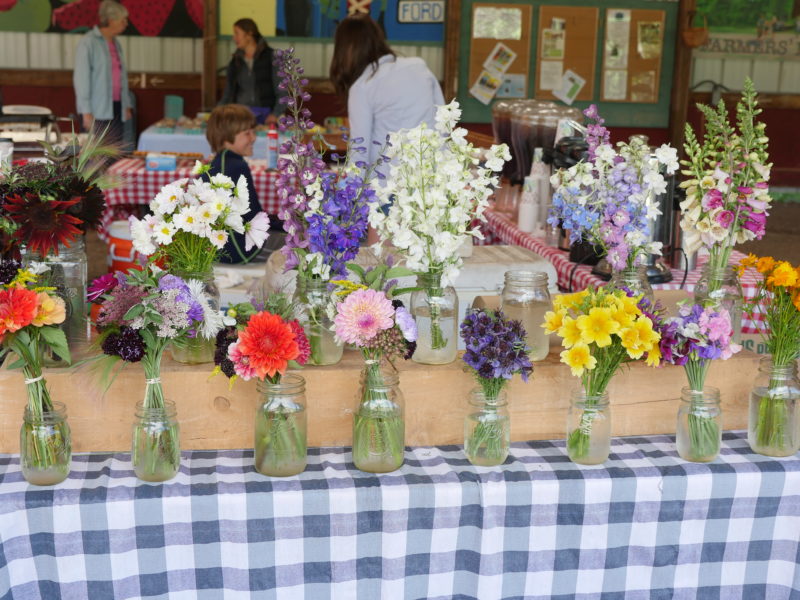

It’s wonderful to be able to walk out into your garden and cut fresh flowers to bring indoors.
With some good planning, you can have cut flowers in the house from April through November. These “cuts” can come from thinning you might do in the formal garden areas or from a spot that you’ve dedicated just for cuts. While some keep their cutting gardens neat and tidy, my preference is to keep the cutting garden slightly hidden so it doesn’t require as much maintenance and primping as a formal garden.
Your cut flowers can be annuals, perennials and even some shrubs like Weigela, Hydrangea, lilacs and more. No matter what your cuts are, though, there are some things to plan, and if some plants require shade, let the taller plants provide the shade. Leave access so you’re not trampling plants while looking for the perfect blooms, buds and stems. Make sure there’s access to water.
Cutting material can be branches, stems, canes or just single flowers that will sit in a single stem vase. To make your flowers last longer, don’t just cut open flowers but flowers that are partially open and buds that may open over a few days. And while daylilies look great in the garden, they are DAY lilies and usually don’t do well as cuts.
Many cuts can be held in the refrigerator, and the fact is that when you buy cut flowers in the market they may have come from Israel, Holland or South and Central America where they are refrigerated right after harvest and shipped on the cold side. A walk-in wine cellar is perfect but a kitchen refrigerator isn’t. Most kitchen refrigerators are automatically defrosted and this takes the humidity or moisture out of the refrigerated air. This will suck the moisture from your cuts and dramatically shorten their usefulness. A cool basement also works great.
I like to take a flower can filled with a few inches of cold water right into the garden and get the flowers into the water within seconds of cutting. You can get these flower cans at many garden centers and the ones that will last the longest are galvanized. Painted cans look great but rust easily and only last a few years.
You can buy floral preservatives to add to the water in your can or vase but this may be unnecessary if you are picking every couple of days and bringing in replacements. I used to throw a tablet of aspirin in the can as that was once said to be a good floral preservative. No, Tylenol, Advil and Aleve will not work, just plain ordinary aspirin.
The absolute best time to make your cuts is early in the morning when it’s cool and the sun hasn’t yet hit the plants. As it gets brighter and warmer the plants wilt easily, but when cut very early in the day they’ll stay turgid and strong. Take your cuts at 3 in the afternoon on a sunny day and your cuts are likely to wilt even before you get them indoors.
•
Every few days I need to walk the property and see what needs staking or restaking. It’s a challenging job when my lilies get 4 feet tall but don’t flower until they’re 6 to 8 feet tall. On these, I use the same stake hole but I need to replace the stakes once or twice as the stems elongate. Stakes and the ties used to hold plants in contact with the stakes should be invisible. A badly placed stake with the wrong color tie can ruin it all. Bamboo comes in two colors, natural and died green. Metal stakes, even plastic covered ones, can vary in color and here you learn that folks who design these stakes must not use them. Some of the “green” stakes don’t correspond with any green that occurs in the garden. Some tree branches work well also but they need to be cut late in the winter. Apple and Beech are my two favorites.
Did you remember which of your tomatoes were determinate and which were indeterminate? Determinates can be staked at planting but indeterminates continue to grow and grow and grow so staking these can be a challenge. For this type of tomato, horizontal staking can be an interesting way to handle them if you have the space.
•
Now’s the time to be planting your fall or second vegetable garden. No newbies, you can’t plant a second crop of corn or tomatoes. The fall veggie garden is saved for those crops that prefer cool growing conditions (but warm starts) or that will remain in the ground well into fall. These cool-season crops include the salad greens, edible-podded peas, broccoli, cabbage and radish among others. Carrots and beets love the heat of August and early September to get started, then the roots, what we’re really after, do really well in the cooler soil, and it’s thought that the cooler soil also sweetens them.
Do successional plantings every 10 days to two weeks but also keep in mind the days to maturity. Carrots and beets can be left in the ground well into November but if overripe or too old they get pithy and hard. Once again, experiment and keep some notes on what you plant, when you plant it and what the results were.
Garlic gets planted in September as soon as the bulbs become available and some onions can be planted and overwintered in the ground then harvested in the spring. The bad news is that the annual Hudson Valley Garlic Festival has been canceled this year so don’t plan on driving up for a taste or for bulbs. Grocery store garlic bulbs won’t work, so get your “sets” locally or buy them online. Keep growing.
 More Posts from Andrew Messinger
More Posts from Andrew Messinger